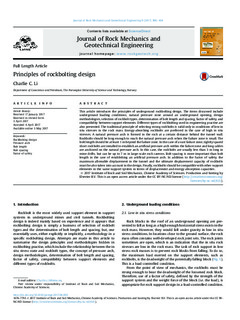| dc.contributor.author | Li, Charlie Chunlin | |
| dc.date.accessioned | 2018-07-30T08:18:03Z | |
| dc.date.available | 2018-07-30T08:18:03Z | |
| dc.date.created | 2018-01-05T15:23:50Z | |
| dc.date.issued | 2017 | |
| dc.identifier.citation | Journal of Rock Mechanics and Geotechnical Engineering. 2017, 9 (3), 396-414. | nb_NO |
| dc.identifier.issn | 1674-7755 | |
| dc.identifier.uri | http://hdl.handle.net/11250/2506717 | |
| dc.description.abstract | This article introduces the principles of underground rockbolting design. The items discussed include underground loading conditions, natural pressure zone around an underground opening, design methodologies, selection of rockbolt types, determination of bolt length and spacing, factor of safety, and compatibility between support elements. Different types of rockbolting used in engineering practise are also presented. The traditional principle of selecting strong rockbolts is valid only in conditions of low in situ stresses in the rock mass. Energy-absorbing rockbolts are preferred in the case of high in situ stresses. A natural pressure arch is formed in the rock at a certain distance behind the tunnel wall. Rockbolts should be long enough to reach the natural pressure arch when the failure zone is small. The bolt length should be at least 1 m beyond the failure zone. In the case of a vast failure zone, tightly spaced short rockbolts are installed to establish an artificial pressure arch within the failure zone and long cables are anchored on the natural pressure arch. In this case, the rockbolts are usually less than 3 m long in mine drifts, but can be up to 7 m in large-scale rock caverns. Bolt spacing is more important than bolt length in the case of establishing an artificial pressure arch. In addition to the factor of safety, the maximum allowable displacement in the tunnel and the ultimate displacement capacity of rockbolts must be also taken into account in the design. Finally, rockbolts should be compatible with other support elements in the same support system in terms of displacement and energy absorption capacities. | nb_NO |
| dc.language.iso | eng | nb_NO |
| dc.publisher | Elsevier Inc. | nb_NO |
| dc.rights | Attribution-NonCommercial-NoDerivatives 4.0 Internasjonal | * |
| dc.rights.uri | http://creativecommons.org/licenses/by-nc-nd/4.0/deed.no | * |
| dc.title | Principles of rockbolting design | nb_NO |
| dc.title.alternative | Principles of rockbolting design | nb_NO |
| dc.type | Journal article | nb_NO |
| dc.type | Peer reviewed | nb_NO |
| dc.description.version | publishedVersion | nb_NO |
| dc.source.pagenumber | 396-414 | nb_NO |
| dc.source.volume | 9 | nb_NO |
| dc.source.journal | Journal of Rock Mechanics and Geotechnical Engineering | nb_NO |
| dc.source.issue | 3 | nb_NO |
| dc.identifier.doi | 10.1016/j.jrmge.2017.04.002 | |
| dc.identifier.cristin | 1536830 | |
| dc.description.localcode | Ó 2017 Institute of Rock and Soil Mechanics, Chinese Academy of Sciences. Production and hosting by Elsevier B.V. This is an open access article under theCCBY-NC-ND license (http://creativecommons.org/licenses/by-nc-nd/4.0/). | nb_NO |
| cristin.unitcode | 194,64,90,0 | |
| cristin.unitname | Institutt for geovitenskap og petroleum | |
| cristin.ispublished | true | |
| cristin.fulltext | original | |
| cristin.qualitycode | 1 | |

